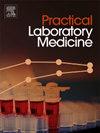Observational assessment of the utilization of donated point of care tests and glycemic control at free and charitable clinics across the United States
IF 1.7
Q3 MEDICAL LABORATORY TECHNOLOGY
引用次数: 0
Abstract
Introduction
Populations experiencing poverty often lack access to convenient lab tests. This analysis assesses trends observed from a national point of care (POC) lab donation program for free and charitable clinics across the United States.
Methods
A total of 16 clinics were selected to receive a comprehensive package of POC lab tests. De-identified data on POC test utilization and results were assessed to descriptively identify trends in utilization (primary objective) and glycemic control (secondary objective). A paired t-test was utilized to identify statistically significant changes in HbA1c from baseline to predefined 90-day time intervals for all people living with diabetes (PLWD) and those with a baseline HbA1c ≥ 9.0 % (75 mmol/mol). The main comparison of interest was the change in HbA1c from baseline to 90–179 days.
Results
A total of 17,563 POC tests were completed for 9658 patients with 3223 tests being HbA1c’s. In the secondary analysis of PLWD with a baseline HbA1c ≥ 9.0 % (75 mmol/mol), patients who completed an HbA1c between 90 and 179 days (n = 188) demonstrated a statistically significant mean reduction from baseline of -1.2 % (95 % CI, -1.6 % to −0.9 %, p < 0.01, -10 mmol/mol [95 % CI, -6 mmol/mol - -14 mmol/mol]).
Discussion
The provision of POC labs helped support the care populations experiencing poverty received at free and charitable clinics, especially for chronic diseases like diabetes.

求助全文
约1分钟内获得全文
求助全文
来源期刊

Practical Laboratory Medicine
Health Professions-Radiological and Ultrasound Technology
CiteScore
3.50
自引率
0.00%
发文量
40
审稿时长
7 weeks
期刊介绍:
Practical Laboratory Medicine is a high-quality, peer-reviewed, international open-access journal publishing original research, new methods and critical evaluations, case reports and short papers in the fields of clinical chemistry and laboratory medicine. The objective of the journal is to provide practical information of immediate relevance to workers in clinical laboratories. The primary scope of the journal covers clinical chemistry, hematology, molecular biology and genetics relevant to laboratory medicine, microbiology, immunology, therapeutic drug monitoring and toxicology, laboratory management and informatics. We welcome papers which describe critical evaluations of biomarkers and their role in the diagnosis and treatment of clinically significant disease, validation of commercial and in-house IVD methods, method comparisons, interference reports, the development of new reagents and reference materials, reference range studies and regulatory compliance reports. Manuscripts describing the development of new methods applicable to laboratory medicine (including point-of-care testing) are particularly encouraged, even if preliminary or small scale.
 求助内容:
求助内容: 应助结果提醒方式:
应助结果提醒方式:


